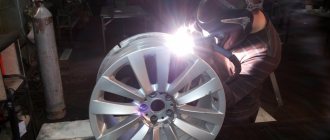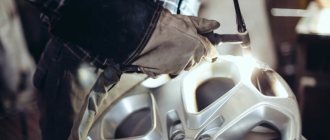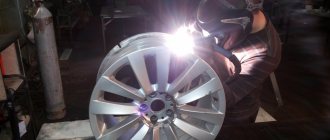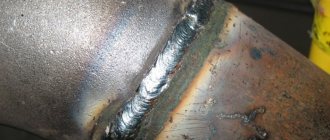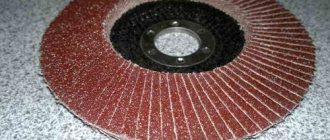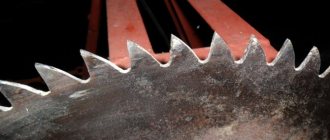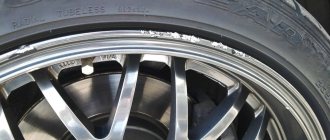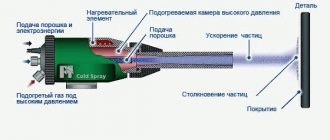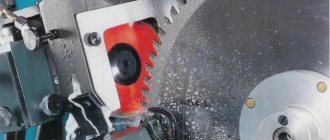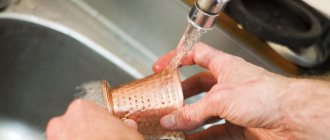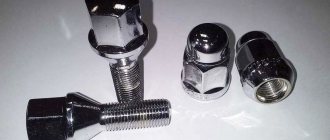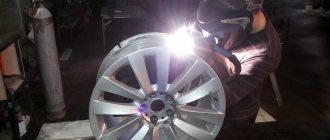- What is special about argon welding?
- Advantages of argon welding
- What disc defects can be eliminated by argon welding?
- Features of the welding process
- Preparatory procedures
- Welding process
- Recommendations
Alloy wheels give the car a stylish appearance, have a long service life, and are able to withstand high loads on uneven road surfaces. Due to their practicality, they are used on most modern cars. No matter how reliable alloy wheels may be, the poor quality of domestic roads will sooner or later lead to cracks, chips and other defects that exclude the further possibility of using the disk.
To repair and restore a damaged disk, welding work will be required. While any method is suitable for welding steel wheels, special technologies are used for light alloy wheels. One of the options that ensures complete restoration of the technical parameters of the disk is argon welding. If you cook the disc in air, the seam will be damaged in a short time and will require repeated repairs. Welding using argon eliminates oxidation of the weld, providing it with high strength and uniformity, almost like the base metal of the disk.
What is special about argon welding?
Alloy wheels contain active metals: aluminum and magnesium. Their peculiarity is that under normal conditions, during the heating process, oxidation occurs on the surface, which does not allow welding two parts in the usual way. In this case, argon-arc welding is used, which involves the use of a protective argon bath.
Argon is an inert gas and does not react chemically with heated metals during welding. The supply of this gas to the welding area creates a protective environment that prevents oxygen molecules from reaching the parts being joined. This eliminates their oxidation and allows you to obtain a strong and reliable seam, which will subsequently withstand enormous loads.
The most effective repair method
The most effective method for restoring disks is argon welding, which involves fusing existing cracks using an electric arc in a protective gas (argon).
The advantages of this type of welding work include the following:
- when working with inert gas, there is no need for special preparation of products (excluding thorough cleaning of damaged areas);
- when welding in an argon environment, an oxide film does not form on the surfaces being restored;
- Repairing disks using this method allows you to restore cast surfaces in the most vulnerable and hard-to-reach places.
The features of this welding method include the need to use a material during repairs, the characteristics of which must correspond to the properties of the metal used in the manufacture of wheels.
Before welding disks with argon, be sure to find out the chemical composition of their material, indicated in the marking applied to the product..
When preparing for restoration, you also need to pay attention to the degree of damage to the disks, which will allow you to correctly select the power of the electric arc apparatus (inverter).
Advantages of argon welding
- possibility of welding non-ferrous and active metals;
- high reliability of the resulting seam;
- the seams are a single whole with the parts being welded;
- after processing and touch-up, the seams do not stand out visually;
- oxidation of the weld is eliminated due to the use of argon protection of the welding area;
- slight heating of the parts being welded, which eliminates their deformation;
- high speed of work performed.
Prices for argon welding
| Services | price, rub. |
| Welding parts from | 500 rub. |
| Welding 1 cm discs | 250 rub. |
| Welding of the front part disk including processing with touch-up paint | 300 rub. |
| Gas dynamic spraying | 250 rub./cm |
The popularity of argon arc welding can easily be justified by such factors as:
- High quality
- Durability
- Reliability
Our company uses only high-quality equipment, which allows us to make the seam from agricultural welding almost invisible, and this has a positive effect not only on the appearance of the product, but also on its strength.
Argon welding is carried out immediately before painting the wheels, polishing and sandblasting, preparing the product for the above procedures.
What disc defects can be eliminated by argon welding?
Due to dynamic loads, various defects may appear on the wheel rims. The following can be eliminated using argon arc welding:
- cracks;
- deep faults;
- deep scratches and nicks;
- chips;
- missing disk fragments.
In the process of eliminating defects, high precision of work and professionalism of the craftsman are important. This will eliminate disc imbalance and possible beats during its operation.
What metal are car wheels cast from?
The main advantage of cast wheels is their excellent appearance and variety of shapes. Unlike stamped steel structures, cast products do not need to be capped to hide any visual imperfections. The presence of such wheels emphasizes the status of the car, which is why almost all luxury brands are equipped with them.
To ensure that in addition to aesthetics, this product is also reliable, it is made from an aluminum-magnesium alloy. Initially, pure aluminum was used, but the final design was not very strong, which necessitated welding of alloy wheels to repair and restore them, and sometimes led to their replacement. The addition of magnesium made the metal more resistant to mechanical stress, although the possibility of damage is still present, especially if the car is used in off-road conditions.
The concentration of magnesium in the alloy varies within 10%. At the same time, well-known manufacturers always indicate the type of metal used on the disk, which greatly simplifies its repair and restoration. The fact is that cracks or chips need to be repaired using electrodes or additives made from exactly the same alloy. Otherwise, the structural strength will not be too high, so it will not be possible to use it as the main wheel.
Process demonstration
Features of the welding process
Welding using the protective environment of inert argon can be carried out using melting and non-melting electrodes. Their diameter is selected depending on the characteristics of the parts being connected. Depending on the composition of the metal of the disk being welded, the type of filler wire is selected. There are three methods of argon-arc welding:
- manual using a non-consumable tungsten electrode;
- automatic using argon and consumable electrodes;
- automatic using argon and non-consumable electrodes;
To repair wheel rims in auto repair shops, manual welding using a non-consumable electrode is mainly used.
Preparatory procedures
To obtain a high-quality and reliable connection, the surfaces to be welded should initially be prepared. This process includes:
- cutting chips and cracks;
- drilling the ends of cracks to relieve excess metal stress;
- cleaning the welded surfaces from the oxide film;
- degreasing of welded edges.
If the disk repair involves welding on the missing element, care should be taken to select a patch made of metal with a similar composition as the disk itself (only homogeneous compositions need to be welded).
Welding process
For welding light alloy wheels, a reverse polarity mode is used.
| Rod | Application |
| 1070 | AD1, Amts |
| 1100 | AD1, Amts |
| 1450 | With the addition of titanium. Used for welding aluminum and its alloys in aircraft construction and the food industry. |
| 4043 | For welding cast Al and Si alloys AD31, AD33, AD35 (ICE blocks, base plates, frames, etc.) |
| 4047 | With the addition of silicon to increase fluidity and reduce shrinkage deformations |
| 5087 | With the addition of Zn to reduce the likelihood of hot cracks. Suitable for welding AL alloys containing up to 5% Mg |
| 5183 | Food industry, marine shipbuilding. For Al-Mg welding; Al-Mn alloys. |
| 5356 | AMg3, AMg4, AMg5, AMg6 |
| 5554 | Tanks for storing chemical materials, car frames and rims. |
| 5556 | For welding Al-Mg T-joints. |
| 5754 | For welding Al-Mg alloys. The seam has high strength and resistance to corrosion. |
A ground is connected to the disk, and a positive potential is applied to the electrode. In this case, the area of increased temperature is localized near the electrode, eliminating excessive overheating of the welded area of the disk.
The inverter sets the welding current. Welding of thin areas of the disk is carried out at a current of up to 120 A, and for the thicker part it increases to 140 A.
To form a protective inert environment, the argon supply is turned on 15...20 seconds before the start of welding. Argon should also be turned off a little after the welding process is completed - approximately after 5...10 seconds.
After applying the operating current, the torch with the electrode is brought as close as possible to the surfaces to be welded, but without contact. The optimal distance would be about 2 mm. Holding the electrode at this distance will allow you to warm up the parts being connected well (without overheating them), obtaining a high-quality and highly reliable seam.
The torch with filler wire should be moved slowly along the direction of the weld being formed. The filler wire is inserted into the arc action area without sudden movements.
During welding, care must be taken not to touch the surfaces being welded with the electrode. Electrode contact with the surface can contaminate the arc and make welding difficult.
To ignite the working arc, oscillators are used, which convert the mains current into high-frequency pulses with a voltage of 2...6 kV and a frequency of 0.15...0.5 kHz. Pulses with such parameters allow you to quickly ignite the arc without the need for contact of the electrode with the surface to be welded.
Recommendations
Filler wire selection
The quality of the created seam largely depends on the correct choice of wire with additives. There are wires with Si, Zn, Ti additives. They are selected depending on the chemical composition of the alloy used to produce the discs. It differs from one manufacturer to another. Therefore, before welding, you need to study the technical passport of the disk, which indicates its composition, or use a special database to help, with information about the composition of the metal for the production of disks by well-known brands.
Defect cutting
In places of defects up to 3 mm deep, cutting involves the creation of V-shaped edges. In the thickened part of the disk, the crack is cut in the shape of the letter “X”. To relieve excess stress, 2 mm holes are drilled at the ends of the cracks. The chipped side needs to be leveled with a grinder.
Before surfacing a longitudinal crack, it is tedious to cut through it to prevent further cracking. For transverse cracks, it is enough to cut them to make the edges even.
Chip repair
The number of layers to be deposited depends on the depth of the chip; the length of the seam should not exceed 30 mm. The stitches of each next layer should be perpendicular to the previous one. The bead should be made with a margin to prevent the appearance of indentations after grinding the welding area.
The procedure for carrying out repair work
The argon arc method of welding damaged disks involves the following procedure for carrying out restoration work:
- preparing surfaces for welding (removing dyes and other protective coatings);
- grinding or chamfering along cracks, simplifying the restoration process;
- selection of the required filler material for argon welding of disks;
- welding a crack (welding a chip) in an argon environment;
- grinding weld spots and treating with protective compounds.
It is most convenient to prepare a product for repair using a hand milling cutter (milling cutter) or grinder with a working disk no more than a millimeter thick.
With their help, longitudinal cracks are cut through, and transverse cracks are expanded to the required size. When preparing the filler material, the nature of the damage is taken into account. So, if the disk bursts, this means that there is a lot of silicon in the source material. In this case, choose wire with a high content of this chemical element.
To correctly select the required type of filler material, please refer to the table
It indicates the rod numbers and characteristics, taking into account the specifics of their application.
The argon welding process itself begins with the deposition of the missing part of the material. Moreover, in this mode the current is usually set to be small (about 120-140 Amperes).
For significant amounts of damage that require metal surfacing, it is better to use the pulse mode.
The build-up of the deposited part is carried out layer by layer with a slight overlap on both sides (excess will be removed during grinding). Welding of the crack begins from the inside, fusing metal in such a way that the resulting seam overlaps it on each side with a margin. Cracks on the outer part of the product are dealt with in exactly the same way.
At the end of the welding operations, labor-intensive work is required to clean and polish the restored surfaces, including cleaning the edges of excess metal and leveling both planes for the tire.
During the cleaning process, areas with insufficient deposited material may be discovered. After identifying them, it will be necessary to re-surfacing and then start processing again.
